Bed bugs have made a remarkable comeback after not being perceived as a pest control threat in the past fifty years or so.
They have a history that dates all the way back to recorded time. It is believed that they may have originated from the Middle East, from caves that were once inhabited by early humans and bats. Studies show that bed bugs shared the same caves where civilization began. The Romans referred to bed bugs as “Cimex.”
They have been found in fossils dating back 3,500 years. They were even used in potions to cure common ailments. Romans and Greeks burned bed bugs as a method of getting leeches to release. Bed bugs were also used to cure snake bites. It is believed that Egyptians actually drank bed bugs.
As civilizations grew, so did the population. By the 1400s, the heat generated by cooking fires made a nice nesting place for the bed bugs within the grandest castles or the crudest dwellings of the less fortunate.
They were a common pest in England from the 17th century to the late 1940s. They had also become a common problem in North America by the late 1800s largely because of immigration and international trade.
As central heating became common in buildings by the early 1900s, infestation became more of a problem and an estimated one-third of all dwellings in European cities had become infested. They were most common in areas where large numbers of people were, such as overcrowded neighborhoods, hotels, restaurants, apartment buildings, furniture shops and laundries were prime for infestation and helped fuel the massive influx of bed bugs during that time.
Different chemicals such as sulfur, mercury, arsenic and pyrethrum were used to control the bed bug epidemic during the late 1800s and early 1900s, but none proved to be very effective at eliminating them.
Fumigation of infected structures using sulfur and later hydrogen iodide gasses proved to be more effective than the previously used insecticides. Despite their effectiveness in killing the insects, these products carried considerable health risks for those using it and to those in close proximity to it.
In the 1940s, D.D.T. became available as a safer insecticide and was able to eliminate them in a room by thoroughly treating the bed. Thus, wide use of D.D.T. dramatically reduced infestation in most industrialized countries.
By the 1950s, bed bugs had developed widespread resistance to D.D.T. Another class of insecticides appeared on the market. The new organophosphates proved to be an effective replacement.
During this time, the use of D.D.T. and organophosphates resulted in the practical eradication of bed bugs in the United States and other developed countries. As a matter of fact, they were no longer considered a common pest in homes or other sites for nearly five decades.
By the late 20th century, bed bugs began showing up again more frequently in hotels near major metropolitan cities, as well as in homeless shelters and low-income housing.
Possible reasons for this resurgence of bed bugs in recent times can be attributed to:
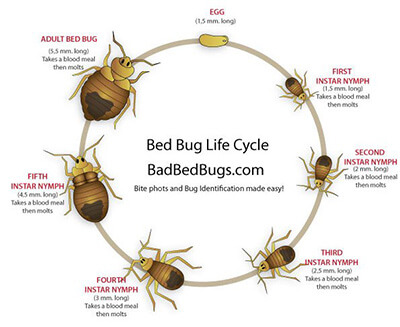 Do you think you have bed bugs?
Do you think you have bed bugs?
Don’t waste time on do-it-yourself treatments, call today and enlist the help of one of our experts.
Yes, it’s true that there are some home remedies you can try at home, such as washing affected items and drying on high heat, vacuuming and even freezing to kill bed bugs.
These methods will help control the bed bugs, but they do not eliminate the problem completely. To completely rid your home, you need professional help.
It’s important know what pest you are dealing with.
Did you know a single female can lay up to 500 eggs?
They are great hitchhikers. They can travel place to place on luggage or clothing. They are in every single region of the country.
The first step is to inspect. Start with your bed. Inspect pillow cases, headboards, mattresses, and furniture. Check along zippers in couch cushions and pillow covers.
Bed bugs are never far from where you are. They stay close to their food source – you.
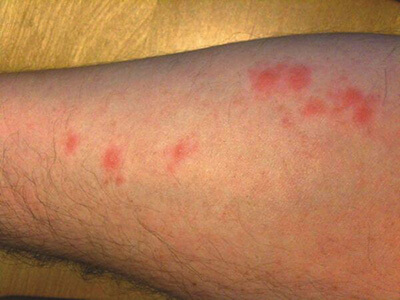 Everyone should inspect their beds and homes on a regular basis for bed bugs. Pull back the sheets and inspect the edging. Check around the box spring too. Look inside drawers and inspect under furniture and cushions. Sometimes bed bugs will even infest curtains.
Everyone should inspect their beds and homes on a regular basis for bed bugs. Pull back the sheets and inspect the edging. Check around the box spring too. Look inside drawers and inspect under furniture and cushions. Sometimes bed bugs will even infest curtains.
When traveling, it is always important to inspect the hotel room thoroughly and keep your luggage on a stand, not on the floor, to avoid any unwanted guests following you back home.
They are very easily seen. An adult is about the size of an apple seed, and its color is dark and brown. Baby bed bugs are about the size of a pin head. They leave behind traces of their presence because they only feed on blood. You will also notice dark spots (dropping) on your mattress or sheets. You might also notice the skin they shed as they grow.
We tend to pick up bed bugs when we travel. They go where we go and return home with us. It’s important to know your enemy. They can climb and crawl.
If you see any of these signs, you need to get professional help as soon as possible.
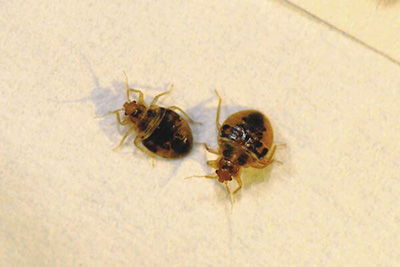 It’s also important to know how you got bed bugs to begin with. They don’t live outside, they only live inside and have to be brought in. Luggage, back packs, and used furniture can carry in bed bugs. Or if you live in an apartment or condominium, they could be coming from your neighbor.
It’s also important to know how you got bed bugs to begin with. They don’t live outside, they only live inside and have to be brought in. Luggage, back packs, and used furniture can carry in bed bugs. Or if you live in an apartment or condominium, they could be coming from your neighbor.
Identifying the common signs of bed bugs will help to properly confirm an infestation in your home or business. Get a professional to come and inspect your home.
A pest control professional will help you identify just how bad the infestation is and help develop a treatment program that will eradicate the infestation.
Extermital’s pest control experts will help you choose the most effective pest control solution to eliminate bed bugs, saving you both time and money.
We use information from PestWorld, Wikipedia and a number of other resources.
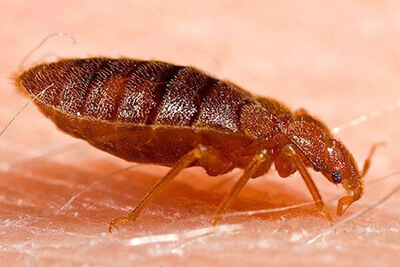 They belong to the family of insects called Cimicidae, which includes over 92 species. Two species, the common bed bug, and the tropical bed bug, use humans as their primary host.
They belong to the family of insects called Cimicidae, which includes over 92 species. Two species, the common bed bug, and the tropical bed bug, use humans as their primary host.
The common bed bug has been found in every state in the United States, while the tropical bed bug has only been found in the states of Florida and Hawaii.
They are flattened wingless insects that cannot fly or jump and feed only on blood. They are straw-colored at the youngest stage, reddish brown at the adult stage and their bodies are covered with short golden hairs. Before feeding, the adults are about the size of an apple seed and are very flat. While the juvenile stages can be as small as a pin head. After feeding, they become swollen and change to dark red in color and have been described as animated blood drops.
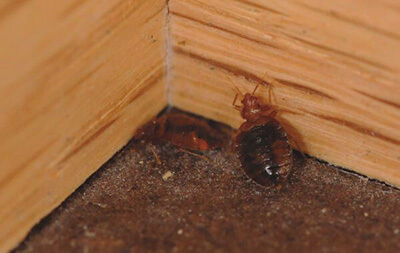 Their eggs, which are commonly found in clusters, are white and shaped like a grain of rice, about half the size of a pin head. Nearly hatched bed bugs are colorless but otherwise resemble the adults.
Their eggs, which are commonly found in clusters, are white and shaped like a grain of rice, about half the size of a pin head. Nearly hatched bed bugs are colorless but otherwise resemble the adults.
They can breed all year round and produce 3 to 6 generations per year. The average lifespan of the bed bug can range from a few months to a little over a year. A female bed bug can lay up over 200 eggs depending on the temperature and the amount of food available. Humans are their primary food source.
As they grow, they need to consume at least one meal before each malt. They will shed their skin five times before turning into adults.
They feed only on blood but can readily survive without feeding 2 to 3 months at 70 degrees F. However, they can live much longer without feeding in colder temperatures.
 Bed bugs excrete liquid fecal material soon after feeding which ranges in color from red, black, yellow or brown. These spots are signs of bed bugs infestations.
Bed bugs excrete liquid fecal material soon after feeding which ranges in color from red, black, yellow or brown. These spots are signs of bed bugs infestations.
Bed bugs prefer to live close to their food source in areas where they are not likely to be seen or disturbed and are usually distributed on or around beds and sofas where people spend long periods of time. They also prefer to live in cracks or crevices, or along edges that prove to add protection.
Another important fact to take note of is that bed bugs have clawed feet, which makes it difficult for them to crawl on some smooth surfaces such as metal, glass, and plastic. Therefore, they prefer to walk on surfaces of texture that enable them to get around easier.
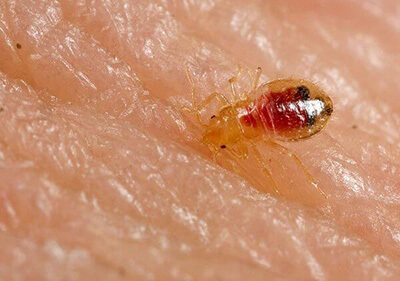 Bed Bugs are attracted to the carbon dioxide and heat produced by a host. Bed bugs are not known to transmit any diseases between humans and other animals, but their bites can cause a wide range of symptoms.
Bed Bugs are attracted to the carbon dioxide and heat produced by a host. Bed bugs are not known to transmit any diseases between humans and other animals, but their bites can cause a wide range of symptoms.
Reactions may include itchiness, welts, rashes and in some cases fever and pain brought on by secondary infections. Scratching the bite sites may also cause further infection.
It is also not uncommon for people to exhibit a delayed onset of symptoms. Some people do not have any reaction at all.
Bed bugs are spread to new locations primarily by normal human activities. For example, someone bringing in infested furniture into your home is a common way from transporting the insect from one location to another.
Travelers may also bring bed bugs to a new place with their infested luggage or they can pick the insects when staying at a hotel or staying with friends or relatives. Bed bugs can also be easily spread through apartments, condominium complexes, dorms, schools, common work areas and other public locations.
The higher the population density, the greater likelihood those bed bugs will spread to neighboring units.
Bed bugs are a real nuisance. But, did you know they can also be a health threat?
Bed Bugs used to be rare, but they have made quite a comeback. They are now widespread throughout the United States and the world. It is important that we know how bed bugs can affect our health.
Bed Bugs feed on the blood of humans and other warm-blooded hosts. They tend to be most active at night because they are attracted to the steady stream of carbon dioxide that we emit when we sleep.
You don’t feel it when a bed bug bites you because the bugs inject an anticoagulant (or blood thinner) along with an anesthetic to create a number affect while they feed. Feeding usually takes five to ten minutes.
If you are bitten by a bed bug, the most common threat is from the bite itself which can turn into a large raised, itchy welt. And, if the welts are scratched, they can become infected. People are more likely to have a severe reaction when they have been repeatedly bitten because the skin becomes sensitized to the bites.
Everyone reacts differently to bed bug bites. In fact, as many as 30 percent of people do not have any reaction at all and may not even realize that they were bitten.
For those people that do have a reaction, the bite can range from a tiny puncture wound to large raised welts. Bites are normally noticed upon awakening, but they can sometimes take two weeks to develop a reaction and be noticed.
Bed bug bites are often lined up in a row on the skin and can be found typically on exposed areas such as the face, neck, hands, legs or arms. These bites can take up to three to six weeks to fully heal.
If an infestation is present, new bites may accumulate even as the old bites disappear. So there might be bite reactions in various stages of evolution all at the same time.
Progressive swelling, warmth, tenderness and in rare cases fever, may be symptoms of secondary infection.
Bed bug bites themselves do not typically require treatment. Itching is by far the most common complaint to those who experience bed bug bites. If itching becomes severe, people can find relief with topical steroid creams or antihistamines. Clean the bite sites with soap and water. Try to avoid scratching the bites, because this can lead to secondary infections.
If a secondary infection occurs, consult your physician. Secondary infections may require antibiotics or other treatments as appropriate.
Bed bug bites can look very similar to other insect bites. So it is important to seek professional help when you suspect your home might be infested with bed bugs.
You can work with a qualified pest professional at Extermital Termite & Pest Control if an infestation is present in your home. We can help you identify your bed bug problems and safely eliminate them from your home by discussing all treatment options to suit your needs.
Bed bug infestations are easily identified by one or more of the following methods: talking to a pest control expert, a visual inspection by a pest control specialist and use of bed bug monitors. K9 scent detection is often used too.
Speaking with a pest control expert provides valuable insight about the infestation history in your home or business, possible sources of the bed bugs and the extent of the infestation.
Although speaking with a pest control expert provides valuable information about your bed bug problems, a visual inspection is necessary to confirm the presence or absence of bed bugs.
A visual inspection is the most common method of identifying bed bugs. It is an effective and simple method to identify moderate to well-established infestations. Detailed inspections by a professional pest control expert can help gather information such as the distribution and severity of the infestation, challenges, and obstacles that affect bed bug treatment.
If bed bugs are not found, but still suspected to be present, your professional pest control expert may advise the use of mattress encasements and bed bug monitoring systems.
The best approach for controlling bed bugs is to use integrated pest management, which is the most effective way to eliminate bed bugs and safeguard people and the environment. This is a sustainable approach to managing bed bugs, which combines biological, physical and chemical tools in a way that minimizes economic, health and environmental risks.
Steps of an integrated pest management program (IPM) are:
“Nighty nite, don’t let the bed bugs bite,” seemed harmless enough when our parents used to say it to us at bedtime, but bed bugs have become a serious problem again today.
Aside from calling in pest control professionals once your home has become infested, a little bit of common sense can go a long way sometimes.
As fun as garage sales or antiquing can be, don’t ever bring home an old or used piece of furniture without first doing a thorough inspection for bed bugs lurking on the surface or in the crevices just waiting to piggyback along and invade your home, feasting on you as you sleep.
Even if you don’t see any bugs, do a careful inspection for any dark stains. Bed bugs are most commonly found on box springs, mattresses, bed sheets, baseboards, headboards, picture frames, luggage, sofas, seat cushions, bed skirts, and baseboards.
It also helps to follow these smart travel tips:
Early detection is very important. If you suspect, your home might be infested with bed bugs, do not delay. Call your pest control professional immediately before the infestation spreads,
Serving Ohio, Kentucky, Indiana

“Take care of the customers you have, and you’ll always have customers to take care of!”.
Your satisfaction is our goal. If you aren’t completely satisfied, we will work with you until you are.
Terry Teague - President of Extermital.